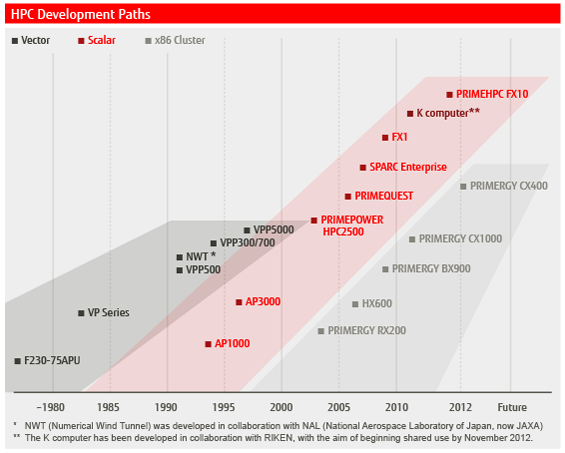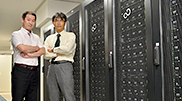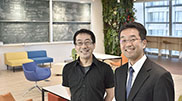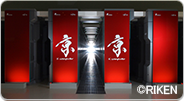Archived content
NOTE: this is an archived page and the content is likely to be out of date.
History
Shaping the evolution of high-performance computing
We have been innovating the high-performance computing space for over 30 years. Back in 1977, we developed our first supercomputer, the FACOM 230-75APU. We went on to develop numerous record-breaking machines, most recently in 2011 with the petascale K computer.
Proof of the commercialization potential of petascale computing, our PRIMEHPC FX10 machine is built on the technology employed in the K computer. The PRIMEHPC FX10 features a next-generation processor architecture, the six-dimensional mesh/torus interconnect technology ("Tofu") developed for the K computer, and an improved cooling design. Those breakthrough technologies provide a scalability that can take the FX10 to a theoretical capacity of more than 20 petaflops.
 HPC Development Paths
HPC Development PathsImpressive track record
- 1977: We developed Japan’s first supercomputer, the "FACOM 230-75APU".
- 1982 onwards: We released a wide range of vector processing models such as the VP-100 series, VP-200 series and VP2000 series.
- 1992: We launched the AP1000 with a massively parallel processing architecture based on an industry-standard scalar processor.
- June 1993: The NWT (Numerical Wind Tunnel) took the number one position on the TOP500 world supercomputer rankings, We developed the NWT in collaboration with NAL (National Aerospace Laboratories, now JAXA).
- June 1994 – Nov. 1995: NWT retained the number one position.
- 1993, 1994 and 1995: NWT was also awarded the Gordon Bell Prize.
- 1993: Our VPP (Vector Parallel Processing) series delivered industry-leading performance based on the world's first vector parallel architecture.
- 1996: We launched the AP3000 series.
- 2002: We combined vector supercomputer technology with large-scale scalar server technology to create the world's fastest supercomputer, PRIMEPOWER HPC2500.
- June 2004: The RSCC (Riken Super Combined Cluster) installed at RIKEN and based on PRIMERGY RX200 cluster nodes ranked Japan’s fastest on the TOP500.
- Nov. 2008: Our FX1 supercomputer installed at JAXA scored highest for computing efficiency in the TOP500 world rankings.
- June 2010: The PRIMERGY BX900 cluster installed at JAEA (Japan Atomic Energy Agency) ranked Japan’s fastest on the TOP500 score.
- June and Nov. 2011: The K computer broke the 10 petaflops speed barrier, taking the number one spot in the TOP500 world supercomputer rankings.
- 2011: We introduced PRIMEHPC FX10, marking the successful commercialization of supercomputing power.


